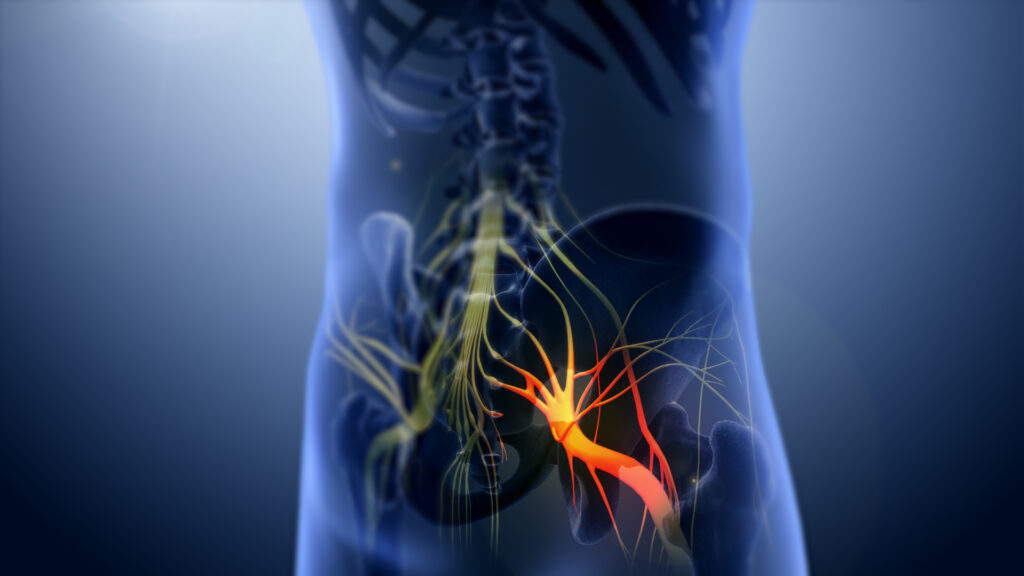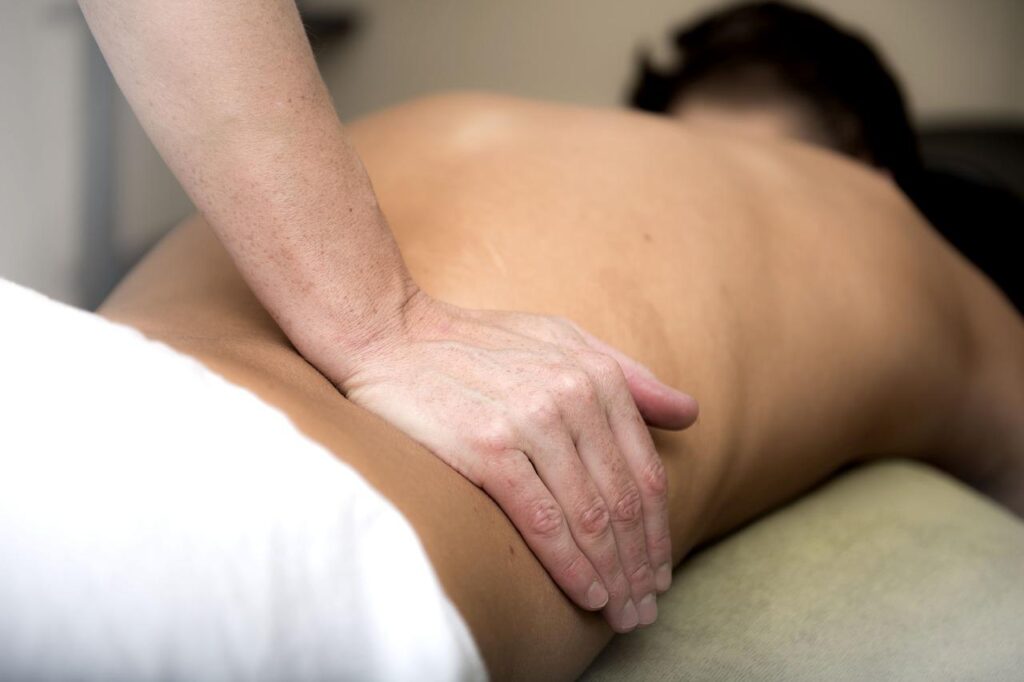Sciatica is a common problem that can cause pain in your lower back, buttocks, and legs. While there are many possible causes of sciatica, mild sciatica can often resolve itself. However, when the symptoms of sciatica do not go away, it’s a good idea to talk to your doctor. Understanding what sciatica is, what causes it, the best treatment for sciatica, and more, can help to understand what the best options are for you.
Anyone can experience sciatica, but it’s more common among older adults and those who lead a sedentary lifestyle. A sedentary life is one where you spend a lot of time sitting or lying down. This can cause strain on your body and put pressure on the nerves that emerge from the lower part of your spine.
Other risk factors include being overweight or obese, having poor posture, or experiencing injury or trauma to the lower back. If you’re experiencing symptoms of sciatica, it’s important to seek medical attention to rule out any underlying conditions or causes.

What is Sciatica?
The sciatic nerve is the longest in your body. It runs from your lower back, through your buttocks, and down to your feet. Many people notice a sharp shooting pain in their lower back or buttocks that radiates down their legs. This is called sciatica, and it’s a symptom of many conditions.
Sciatica occurs when this nerve is compressed or inflamed. This compression can be due to a bulging disc, bone spur, herniated disc, or muscle spasms, though other causes do exist as well. While there are many treatments for sciatica, it’s important to understand what’s causing the compression. Once the underlying cause is determined, treatment options can be more easily discussed with your doctor.
Underlying Causes Of Sciatica
There are many potential causes of sciatica, but some of the most common ones include:
A bulging disc:
This occurs when the disc between your vertebrae bulges out of place and places pressure on the sciatic nerve.
A herniated disc:
This can occur when the jelly-like center leaks out of a damaged disc and irritate nearby nerves.
Bone spurs:
A bone spur is an abnormal bony growth that can form along the vertebrae, causing compression of the nerve.
A spinal tumor:
When a tumor forms on the spine, it can cause compression of nearby nerves.
Spinal stenosis:
This is a narrowing of the spinal cord or spinal canal that can compress the sciatic nerve.
Obesity:
Carrying around extra weight can put more pressure on your spine, causing sciatica symptoms. It can also lead to accelerated degeneration (arthritis) that can irritate the nerve.
Trauma:
A car accident or other type of injury can cause damage to the spine, resulting in compression of the sciatic nerve.
Pregnancy:
The added weight during pregnancy can put pressure on the sciatic nerve, resulting in pain.
Arthritis:
Osteoarthritis and other forms of arthritis can damage the spine, leading to sciatica symptoms.
Degenerative disc disease:
This is when the discs that cushion your vertebrae start to wear down. The resulting changes can cause irritation to your nerves.
Piriformis syndrome:
This occurs when a muscle in your buttocks (the piriformis) compresses the sciatic nerve.
Spondylolisthesis:
This occurs when one vertebra slides over another, irritating the nerves that create the sciatic nerve.
Symptoms of Sciatica
The symptoms of sciatica can vary depending on the underlying cause. However, the most common symptom is a shooting pain that radiates from your lower back down your legs. Other symptoms may include numbness, tingling, weakness, or a burning sensation. Sciatica can also cause muscle spasms in the affected leg. Some people experience mild discomfort, while others may have severe pain that makes it difficult to move or stand up.
The sciatic nerve pain may get worse when you cough or sneeze, and you may have trouble moving your legs or feet. You may also experience pain when sitting down for long periods of time. Sciatica can also cause other problems, such as incontinence (loss of control over your bladder or bowels).
Sciatica pain is often severe, but it can also be mild. If you’re experiencing any signs of sciatica, it’s important to talk to your doctor so that the cause can be determined, and treatment options are discussed.
Diagnosing Sciatica
If you experience any signs of sciatica, your doctor will conduct a physical exam to determine the cause. They may also order various tests, such as an X-ray or MRI scan, in order to locate the source of the problem. Once they have identified the cause, they can discuss treatment options with you.
Treatment Options for Sciatica
There are many treatment options available for those suffering from sciatica. The best option will depend on the underlying cause of your symptoms. Some common treatments include:
Rest:
This is often the first line of treatment. You may need to take a few days off from work or other activities. Nearly 80-90% of people with sciatic nerve pain get better within a few weeks.
Ice:
Applying ice to the affected area can help reduce swelling and pain.
Heat:
This can be used to help relax muscles and provide pain relief.
Exercise:
Once the pain has subsided, you may want to start doing some gentle exercises to strengthen your back and improve flexibility. Light aerobic exercises like swimming, walking, or pool therapy have been shown to provide sciatic pain relief.
Chiropractic adjustments:
Chiropractors specialize in treating spinal disorders and may be able to help alleviate sciatica pain by correcting any misalignment in the spine. Chiropractors can also provide stretching, strengthening, posture, and nutritional advice to speed up recovery and mitigate relapses.
Physical therapy:
A physical therapist can teach you exercises and stretches to help relieve pain and improve function. Physical therapy can also help correct poor posture and strengthen muscles that support your lower back. Stretching has been shown to provide pain relief and help reduce the chances of further injury.

Massage therapy:
This can help relax muscles and reduce pain. It can also increase the blood flow in the area or help with anything that is pinching or compressing the sciatic nerve.
Acupuncture:
This ancient Chinese practice involves inserting needles into the skin to promote healing. It has been shown to help reduce sciatica pain and improve function.

Medications:
Non-steroidal anti-inflammatory drugs (NSAIDs) such as ibuprofen can help with pain and inflammation, while other medications may be prescribed for nerve pain.
Surgery:
In some cases, surgery may be necessary to remove a herniated disc or other structures that are putting pressure on the sciatic nerve.
Lifestyle changes:
Maintaining a healthy weight, strengthening your core, quitting smoking, and improving your posture can all help reduce the chances of developing sciatica or experiencing a flare-up.
In rare cases, delaying or avoiding medical care could lead to or cause permanent nerve damage.
Treatments Are Often Trial and Error
There is no one-size-fits-all treatment for sciatica. What works for one person may not work for another. You may need to try a few different treatments before you find the one that works best for you. If your pain is severe, you may need to see a doctor or other healthcare provider to get relief.
There are also medications, like NSAIDs, that can help reduce inflammation and manage pain. In some cases, surgery may be necessary to correct the underlying problem. However, this is usually only recommended if other treatments have failed.
Sciatica can be a debilitating condition, but there are many treatment options available. If you are experiencing any symptoms of sciatica, it’s important to talk to your doctor so that the cause can be determined, and proper treatment can be started.

Chiropractic Care and Sciatica Pain
Chiropractic care is one of the most popular treatment options for sciatica. Chiropractors specialize in treating disorders related to the spine and nervous system, so they’re uniquely qualified to alleviate pain caused by sciatica.
In addition to chiropractic adjustments, many chiropractors also use other methods, such as massage and stretching, to help reduce pain and improve function. More and more people are turning to chiropractic care for relief from sciatica.
Talk to Thrive! Wellness Center Today
If you’re struggling with sciatica and are looking for an effective treatment option, talk to Thrive! Wellness Center today. Our team can help you find relief from your symptoms and work towards correcting the underlying cause, so you can regain full function and improve your quality of life.
To learn more or book an appointment, contact us at (727) 381-3456 or by visiting here.


